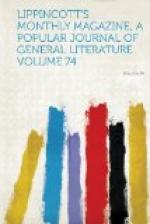Impressions et Souvenirs. Par George Sand. Paris: Levy Freres; New York: F.W. Christern.
This little collection of papers is made from Madame Sand’s private journal, the extracts being sometimes recent and sometimes thirty years old, sometimes short and sometimes improved into essays, and in any case stitched together by the slightest of threads. A few allusions, hardly important enough to be called anecdotes, reveal the relations of the authoress with the great men of the time, and the least momentous recital becomes charming from the assured ease and native grace of this veteran artist’s style. One amusing reminiscence is the odd paradox of Theophile Gautier, that plants are unwholesome absorbents of vital air, and that for him the ideal of a garden would be a succession of asphaltum paths, with fine-cushioned seats, and narghiles for ever burning in the guise of flowers and shrubbery. A retort of Sainte-Betive’s shows the sincerity of his free-thinking opinions. Madame Sand having declared that she was sure we had three souls—one for our bodily organs, one for society and one for worship—the critic replied, “I wish we could be sure that we had one.” There is a delightful chapter, dated 1831, where Chopin and Delacroix encounter each other at the author’s Paris home, where the painter explains the principle of reflections to Maurice Sand, and Chopin plays the piano so entrancingly for his auditor that the episode of a bed-room on fire passes by unnoticed. Of Maurice Sand, gifted son of an inspired mother, there is an exquisite chapter of literary criticism tempered with maternity. Other papers treat of infantine instruction as practiced by the writer herself, and readers are conscious of a thrill of envy at the thought of that little circle of Dudevantine grandchildren learning the elements of spelling and grammar from such a mistress of style, and with all the advantages due to the noble teacher’s genius for simplification. A chapter on punctuation, which has been largely quoted both in French and English, is incorporated, and there are eventless and fascinating records of the wonderful drives around Nohant. The little brochure is a pure cup of refreshment.




